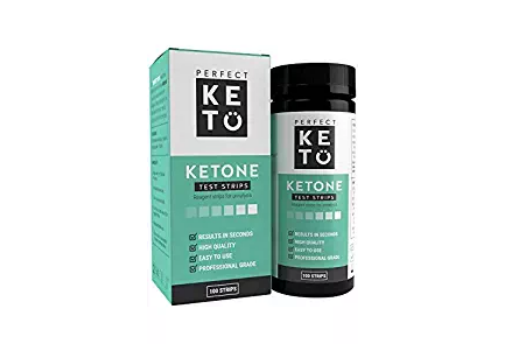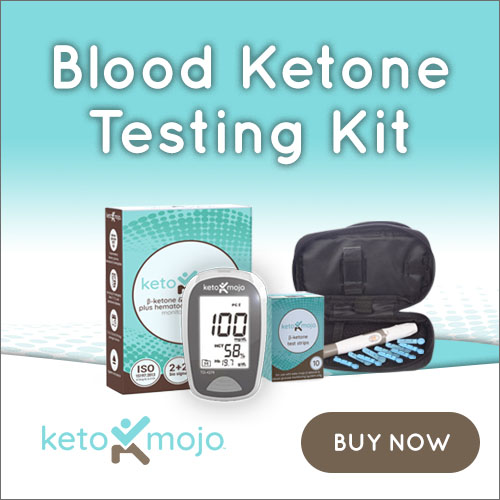The ketogenic diet is in high fat, moderate protein, low carbohydrate diet. And by following the ketogenic diet, you’re changing your metabolism to run of fatty acids or ketone bodies.
When this process occurs it’s called fat adapted.
What this means is that your body is now adapted to run off of fatty acids/ketones even while you’re at rest.
Which is pretty cool.
Because what it means is that you literally burn fat at rest.
No exercise required and who doesn’t want that?
Research has shown that following a ketogenic diet also improves your body’s sensitivity to insulin. What this does is helps you to better control blood sugar and lowers inflammation. The biggest benefit is that it all leads to greater fat metabolism, improved muscle development and lowers your risk of developing chronic health problems like diabetes and heart disease.
And as great as the ketogenic diet is, people are always a little confused about how exactly they should be measuring their ketones.
In this article I’ll explain the most common ways to measure ketones and give you my opinion as to which is actually the best.
What are Ketones?
When it comes to ketones, there are three types of ketone bodies. Acetone, Acetoacetate and Beta-Hydroxybutryate (BHB). Each one of these can be tested. Acetone is a ketone released through the breath, Acetoacetate is a ketone released through urine and Beta-Hydroxybutryate (BHB) (although not technically a ketone it acts like a ketone) is tested in the blood.
Most people will enter into a light nutritional ketosis (between 0.5-1.0 mmol/L on the meter) within two or three days.
It typically takes two to three weeks to get into a stable and optimal ketosis of 1.5-3.0 mmol/L.
Testing Your Blood Ketone Levels.
Testing your blood for BHB levels is considered to be the most accurate way to measure ketones. But don’t worry… For those a bit squeamish there are other ways and we’ll cover those too. My favorite device for testing your blood is the Keto Mojo.
What I like about it is that it also tests blood glucose which can be really helpful. I’ll explain why in just a moment.
Essentially, it’s a finger prick you do each morning as soon as you wake up and it’s a great tool for assessing your level of ketosis.
After you buy the meter which is a one-time cost, test strips will run you about $30 per month if you test once per day.
I personally use the Keto Mojo every day and I love it.
It’s really not painful at all, but if you hate the site of blood you can use one of the other methods.
Like breath testing.
Testing ketones from your breath is a non-invasive and cheaper alternative. And the medical research confirms that it’s a reliable way to test. Although it won’t give you specific numbers, instead it will just let you know if you’re in a certain range. One device I like is the Ketonix Acetone Breath Analyzer.

Here’s what the ranges look like when you test with a Ketonix meter.
They’re represented by colored LED lights:
Blue = 0 – 150 nmol/L
Green = 150 – 400 nmol/L (Small)
Yellow = 400 – 930 nmol/L (Moderate)
Red = > 930 nmol/L (Large)
Both the yellow and red range are considered to correlate with nutritional ketosis.
The benefit is that it’s easy and relatively inexpensive to test your breath.
Keep in mind however, that breath ketones don’t always match blood ketones and can vary based on alcohol consumption and even your water intake. Again, I think first thing in the morning is best before that first cup of coffee.
Probably the most common way to test ketones is through the use of urine test strips. 
It’s definitely the cheapest way to test but it can also be inaccurate. Mostly because the body will naturally excrete more ketones before you’re keto or fat adapted than after you adapt. So, when you’re first starting you can have higher numbers that gradually go down as get into ketosis. Changes in fluid intake can also change the results. If you drink lots of water like I recommend, then you’ll probably be diluting your urine ketone levels.
And if you don’t feel like testing at all my suggestion is to go by how you feel.

It’s a great idea to keep a journal.
Are you feeling better, are you shedding pounds, sleeping better?
If so, you are probably on the right track. Personally, I like to measure.
But hey…I get it. Some people are just about the feel of it all.
However, if your progress stalls or you’re just not seeing the results you want my suggestion is to start testing.
Once you get a feel for how your body responds and where your ketones are on any given day.
You can dial it all in and then go back to just feeling your way through it. Finally, I’d like to touch on one more thing.
Testing Your Blood Glucose.
If you decide to use the Keto Mojo like I do, you also have the benefit of checking your blood sugar too.
When you are primarily using sugar for fuel your body is extremely sensitive to low blood sugar and will release hormones to get your blood sugar back up again.
Ideally, the key range for this is around 75-80 mg/dl. Hypoglycemia is usually diagnosed when blood sugar levels dip under 70 mg/dl in a fasting state.
Under normal circumstances, when your blood sugar levels drop below 80 mg/dl your body releases cortisol which causes the release of glycogen (stored sugar)from your muscles and liver.
This is a natural response seen primarily when your body is dependent on sugar.
This pattern of blood sugar imbalances results in the craving of sugars and sweets.
You can also experience fatigue and brain fog as well as difficulty sleeping and mood disturbances.
However, when you follow the ketogenic diet and are in ketosis and fat adapted, you can be in the hypoglycemic range (under 70mg/dl) and still feel great.
You’ll still have abundant energy, mental focus and stamina, be in a good mood and sleep like a baby.
This is a sign that your body has adapted to using ketones and is not dependent on sugar as its primary fuel source.
When this happens your body isn’t so concerned with a drop in blood sugar, because it doesn’t need it.
Make sense?
Bottom line here is that it’s a good idea to test. It helps you stay on track both mentally and physically and it helps you to better understand why you’re feeling good or bad so that you can make adjustments.
Now the whole reason to test is to make sure that you’re in ketosis, right?
But what if you’re not doing keto right? A lot of people don’t.
That’s why I created the Two-Week Keto Challenge.
It’s the fastest, easiest most effective keto program around AND it’s super simple to follow.
If you haven’t joined The Two-Week Keto Challenge, what are you waiting for?
Inside the challenge, you’ll discover everything you need to know in order to do keto the right way.
Plus, you’ll actually have ketones to measure.
Sound good?
Join us by clicking the link below.
Click here to join the Two-Week Keto Challenge and start your keto journey completely risk-free.







